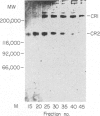Abstract
The receptor for the C3d fragment of the third component of complement, CR2, has recently been shown also to act as the receptor for the Epstein-Barr virus (EBV) and to be involved in the control of B-cell proliferation. In order to define functionally important domains on this molecule, we produced monoclonal antibodies to several distinct epitopes. CR2 was purified from a NP-40 lysate of human tonsils by a new method involving sequential chromatography on lentil lectin Sepharose 4B and DEAE-Sephadex and used to immunize mice. After fusion we obtained four stable hybridoma lines producing antibody to CR2. Specificity of these antibodies for CR2 was ascertained by immunofluorescence analysis on a panel of various cells known to possess CR2, by their reactivity in a recently described ELISA for C3 receptors, by Western blotting with purified CR2 and immunoprecipitation from 125I-labelled Raji cells. These four antibodies were found to recognize three distinct epitopes localized on the same fragments of 95,000, 72,000, 50,000, 32,000 and 28,000 MW obtained after mild tryptic digestion of CR2. The 72,000 MW fragment contains the binding site for C3d. Two monoclonal antibodies recognizing the same epitope did not inhibit the binding of C3d-coated sheep erythrocytes to Raji cells, whereas the other two antibodies against distinct epitopes did inhibit in the presence of a second antibody. All four monoclonal antibodies stimulated the proliferation of human peripheral blood B cells.
Full text
PDF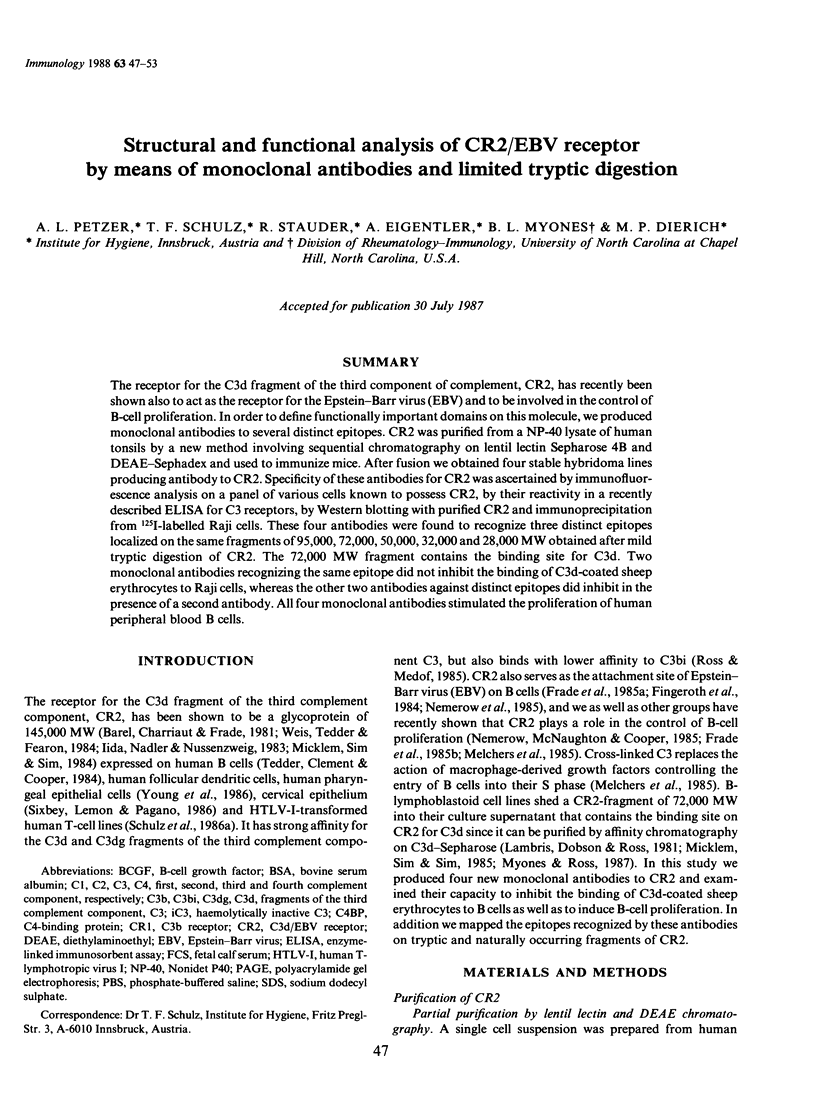
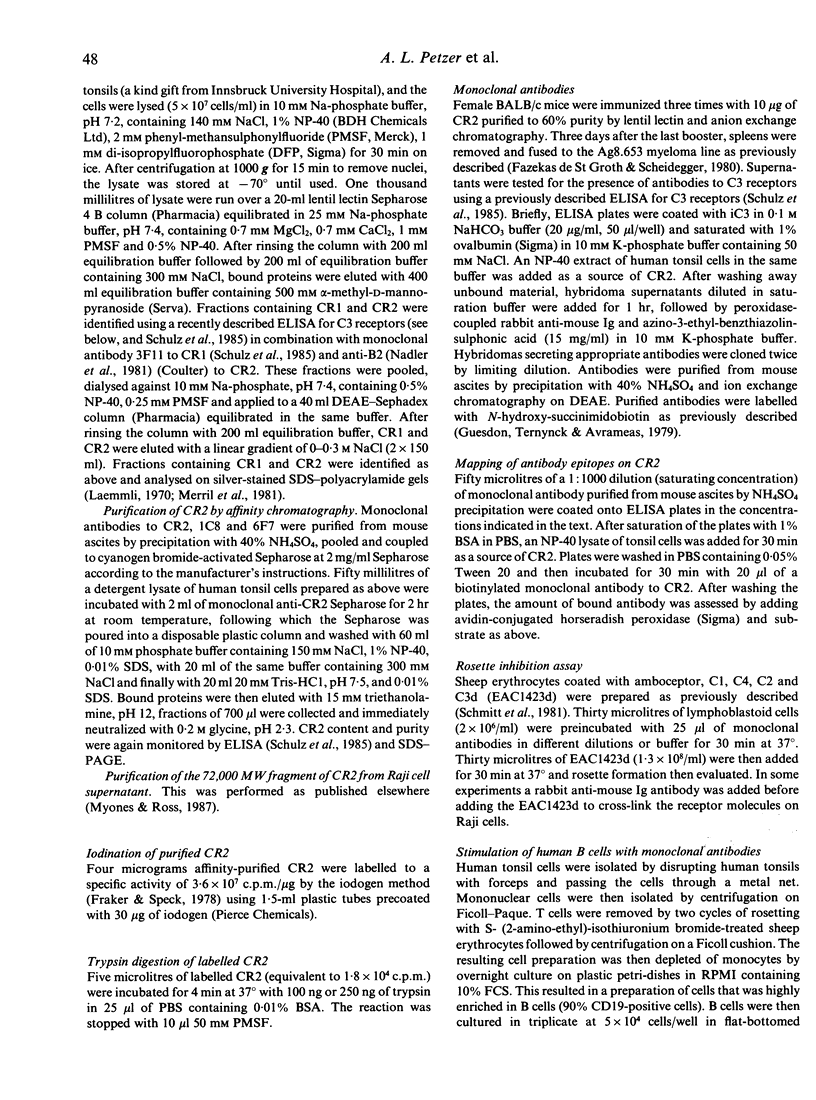
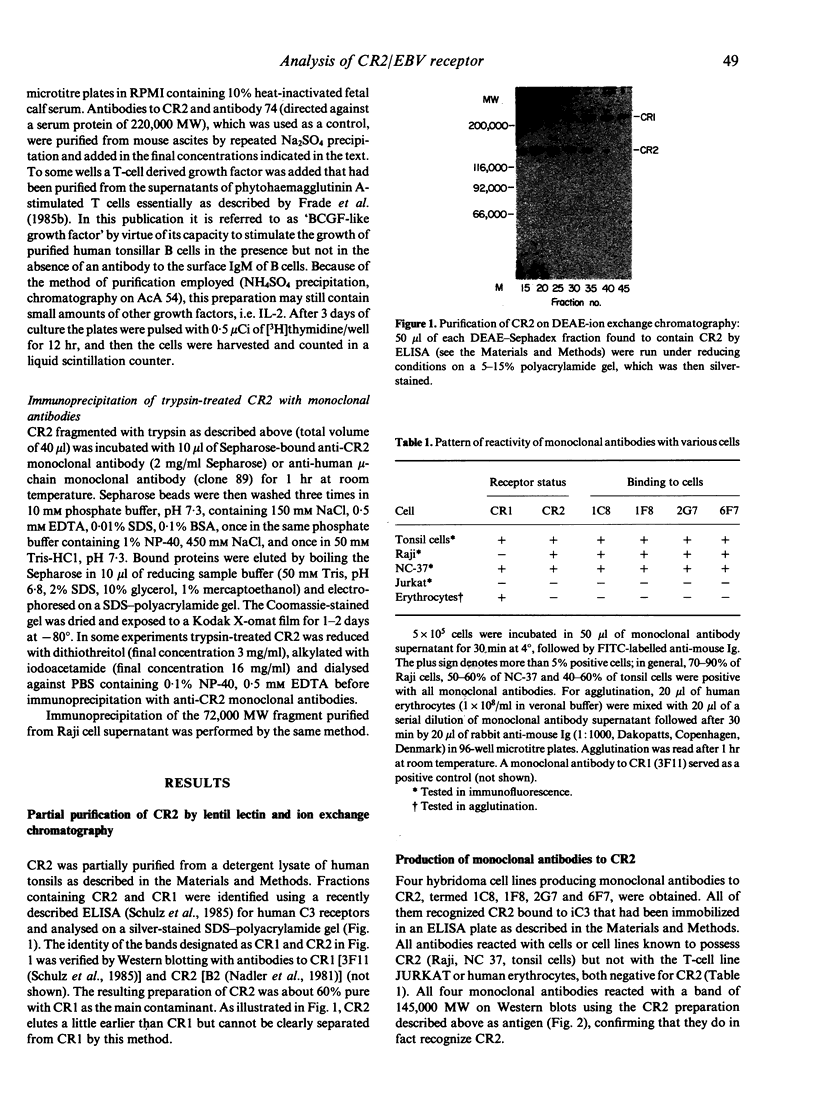
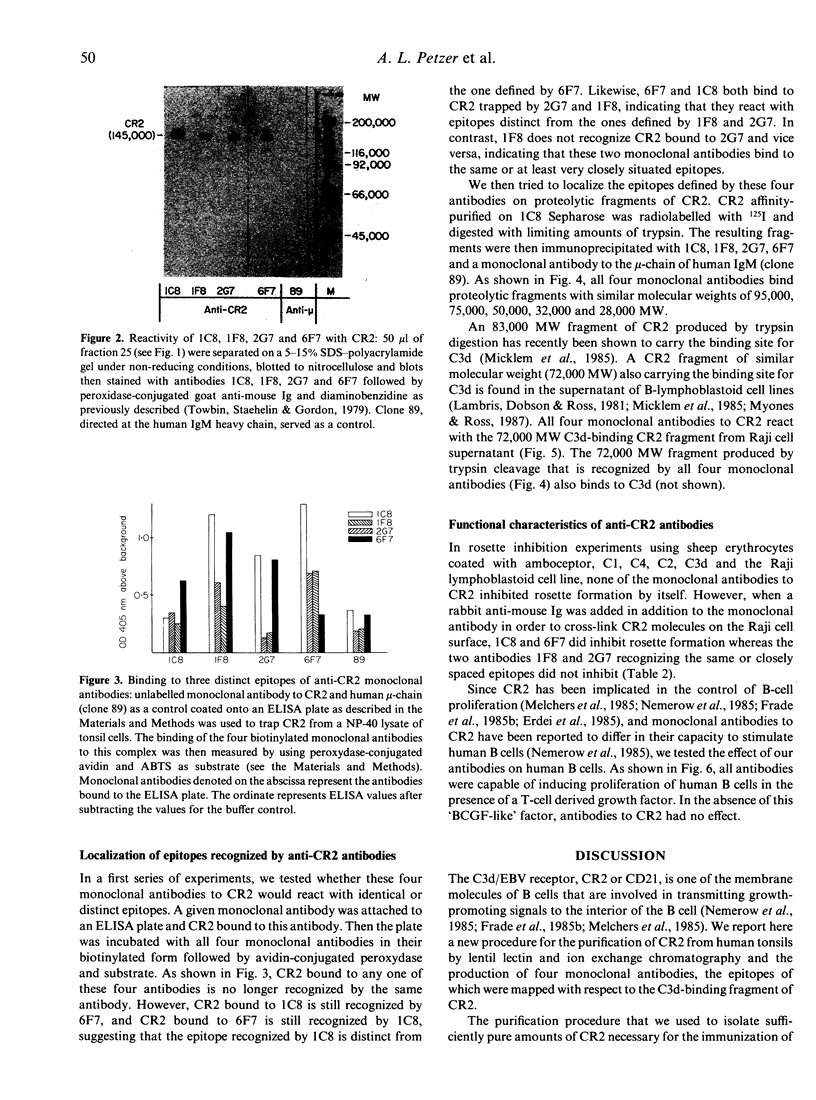
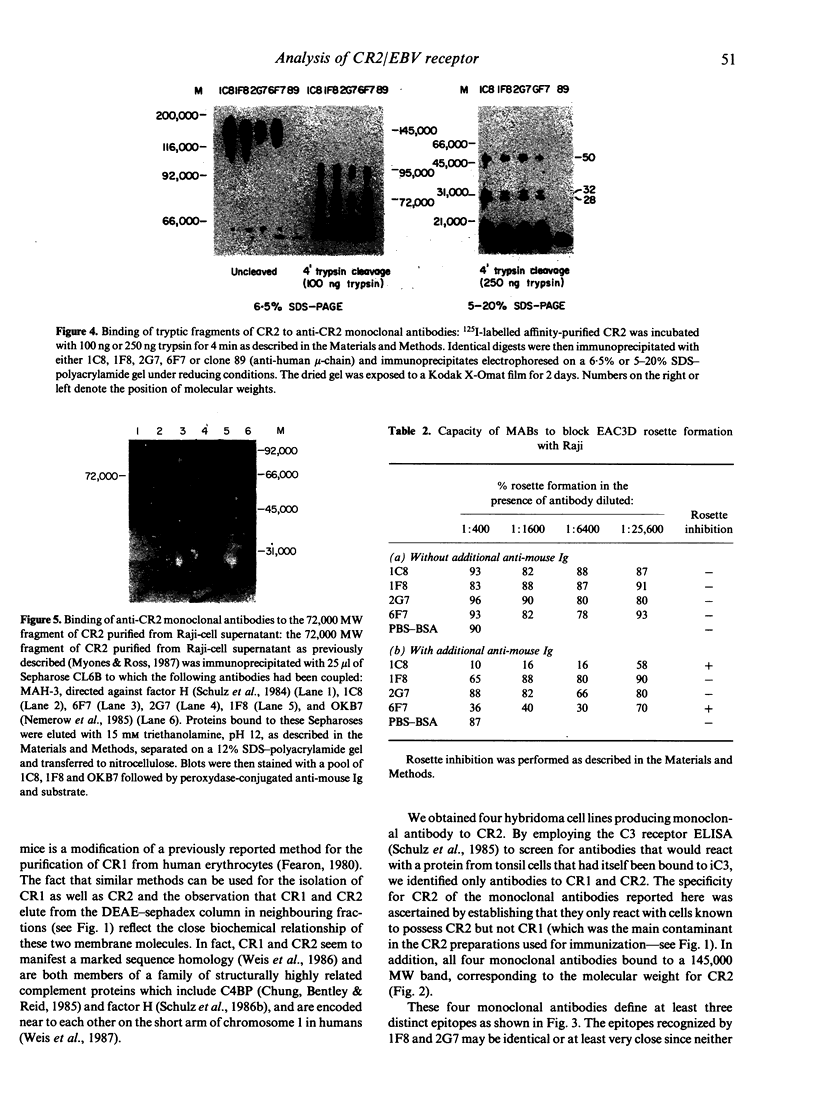
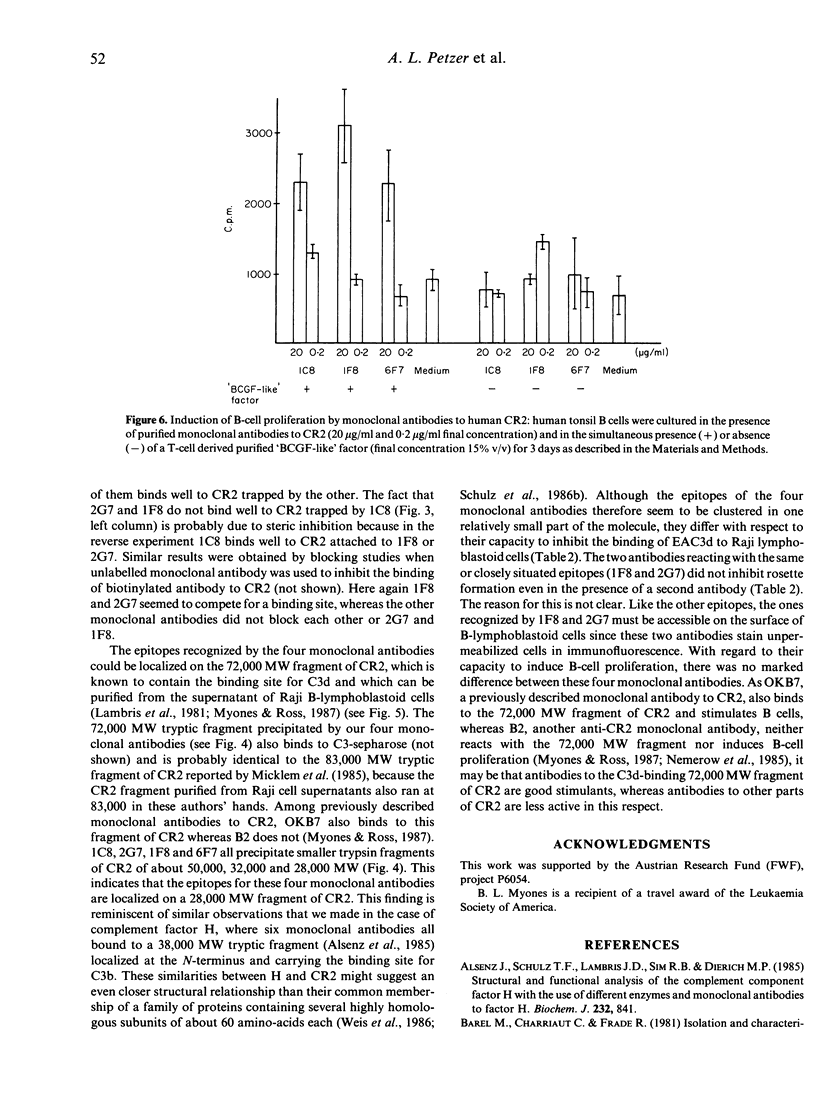
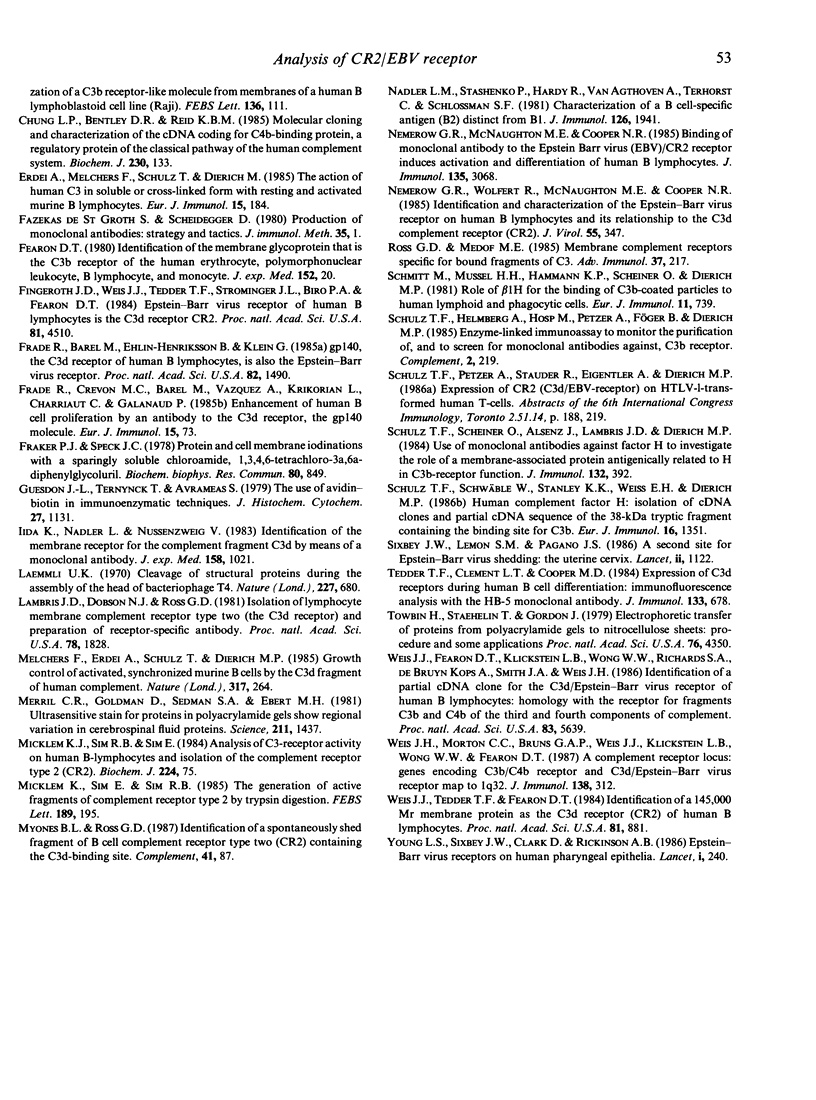
Images in this article
Selected References
These references are in PubMed. This may not be the complete list of references from this article.
- Alsenz J., Schulz T. F., Lambris J. D., Sim R. B., Dierich M. P. Structural and functional analysis of the complement component factor H with the use of different enzymes and monoclonal antibodies to factor H. Biochem J. 1985 Dec 15;232(3):841–850. doi: 10.1042/bj2320841. [DOI] [PMC free article] [PubMed] [Google Scholar]
- Barel M., Charriaut C., Frade R. Isolation and characterization of a C3b receptor-like molecule from membranes of a human B lymphoblastoid cell line (Raji). FEBS Lett. 1981 Dec 21;136(1):111–114. doi: 10.1016/0014-5793(81)81225-2. [DOI] [PubMed] [Google Scholar]
- Chung L. P., Bentley D. R., Reid K. B. Molecular cloning and characterization of the cDNA coding for C4b-binding protein, a regulatory protein of the classical pathway of the human complement system. Biochem J. 1985 Aug 15;230(1):133–141. doi: 10.1042/bj2300133. [DOI] [PMC free article] [PubMed] [Google Scholar]
- Erdei A., Melchers F., Schulz T., Dierich M. The action of human C3 in soluble or cross-linked form with resting and activated murine B lymphocytes. Eur J Immunol. 1985 Feb;15(2):184–188. doi: 10.1002/eji.1830150214. [DOI] [PubMed] [Google Scholar]
- Fearon D. T. Identification of the membrane glycoprotein that is the C3b receptor of the human erythrocyte, polymorphonuclear leukocyte, B lymphocyte, and monocyte. J Exp Med. 1980 Jul 1;152(1):20–30. doi: 10.1084/jem.152.1.20. [DOI] [PMC free article] [PubMed] [Google Scholar]
- Fingeroth J. D., Weis J. J., Tedder T. F., Strominger J. L., Biro P. A., Fearon D. T. Epstein-Barr virus receptor of human B lymphocytes is the C3d receptor CR2. Proc Natl Acad Sci U S A. 1984 Jul;81(14):4510–4514. doi: 10.1073/pnas.81.14.4510. [DOI] [PMC free article] [PubMed] [Google Scholar]
- Frade R., Barel M., Ehlin-Henriksson B., Klein G. gp140, the C3d receptor of human B lymphocytes, is also the Epstein-Barr virus receptor. Proc Natl Acad Sci U S A. 1985 Mar;82(5):1490–1493. doi: 10.1073/pnas.82.5.1490. [DOI] [PMC free article] [PubMed] [Google Scholar]
- Frade R., Crevon M. C., Barel M., Vazquez A., Krikorian L., Charriaut C., Galanaud P. Enhancement of human B cell proliferation by an antibody to the C3d receptor, the gp 140 molecule. Eur J Immunol. 1985 Jan;15(1):73–76. doi: 10.1002/eji.1830150114. [DOI] [PubMed] [Google Scholar]
- Fraker P. J., Speck J. C., Jr Protein and cell membrane iodinations with a sparingly soluble chloroamide, 1,3,4,6-tetrachloro-3a,6a-diphrenylglycoluril. Biochem Biophys Res Commun. 1978 Feb 28;80(4):849–857. doi: 10.1016/0006-291x(78)91322-0. [DOI] [PubMed] [Google Scholar]
- Guesdon J. L., Ternynck T., Avrameas S. The use of avidin-biotin interaction in immunoenzymatic techniques. J Histochem Cytochem. 1979 Aug;27(8):1131–1139. doi: 10.1177/27.8.90074. [DOI] [PubMed] [Google Scholar]
- Iida K., Nadler L., Nussenzweig V. Identification of the membrane receptor for the complement fragment C3d by means of a monoclonal antibody. J Exp Med. 1983 Oct 1;158(4):1021–1033. doi: 10.1084/jem.158.4.1021. [DOI] [PMC free article] [PubMed] [Google Scholar]
- Laemmli U. K. Cleavage of structural proteins during the assembly of the head of bacteriophage T4. Nature. 1970 Aug 15;227(5259):680–685. doi: 10.1038/227680a0. [DOI] [PubMed] [Google Scholar]
- Lambris J. D., Dobson N. J., Ross G. D. Isolation of lymphocyte membrane complement receptor type two (the C3d receptor) and preparation of receptor-specific antibody. Proc Natl Acad Sci U S A. 1981 Mar;78(3):1828–1832. doi: 10.1073/pnas.78.3.1828. [DOI] [PMC free article] [PubMed] [Google Scholar]
- Melchers F., Erdei A., Schulz T., Dierich M. P. Growth control of activated, synchronized murine B cells by the C3d fragment of human complement. Nature. 1985 Sep 19;317(6034):264–267. doi: 10.1038/317264a0. [DOI] [PubMed] [Google Scholar]
- Merril C. R., Goldman D., Sedman S. A., Ebert M. H. Ultrasensitive stain for proteins in polyacrylamide gels shows regional variation in cerebrospinal fluid proteins. Science. 1981 Mar 27;211(4489):1437–1438. doi: 10.1126/science.6162199. [DOI] [PubMed] [Google Scholar]
- Micklem K. J., Sim R. B., Sim E. Analysis of C3-receptor activity on human B-lymphocytes and isolation of the complement receptor type 2 (CR2). Biochem J. 1984 Nov 15;224(1):75–86. doi: 10.1042/bj2240075. [DOI] [PMC free article] [PubMed] [Google Scholar]
- Micklem K., Sim E., Sim R. B. The generation of active fragments of complement receptor type 2 by trypsin digestion. FEBS Lett. 1985 Sep 23;189(2):195–201. doi: 10.1016/0014-5793(85)81022-x. [DOI] [PubMed] [Google Scholar]
- Nadler L. M., Stashenko P., Hardy R., van Agthoven A., Terhorst C., Schlossman S. F. Characterization of a human B cell-specific antigen (B2) distinct from B1. J Immunol. 1981 May;126(5):1941–1947. [PubMed] [Google Scholar]
- Nemerow G. R., McNaughton M. E., Cooper N. R. Binding of monoclonal antibody to the Epstein Barr virus (EBV)/CR2 receptor induces activation and differentiation of human B lymphocytes. J Immunol. 1985 Nov;135(5):3068–3073. [PubMed] [Google Scholar]
- Nemerow G. R., Wolfert R., McNaughton M. E., Cooper N. R. Identification and characterization of the Epstein-Barr virus receptor on human B lymphocytes and its relationship to the C3d complement receptor (CR2). J Virol. 1985 Aug;55(2):347–351. doi: 10.1128/jvi.55.2.347-351.1985. [DOI] [PMC free article] [PubMed] [Google Scholar]
- Ross G. D., Medof M. E. Membrane complement receptors specific for bound fragments of C3. Adv Immunol. 1985;37:217–267. doi: 10.1016/s0065-2776(08)60341-7. [DOI] [PubMed] [Google Scholar]
- Schmitt M., Mussel H. H., Hammann K. P., Scheiner O., Dierich M. P. Role of beta 1H for the binding of C3b-coated particles to human lymphoid and phagocytic cells. Eur J Immunol. 1981 Oct;11(10):739–745. doi: 10.1002/eji.1830111002. [DOI] [PubMed] [Google Scholar]
- Schulz T. F., Helmberg A., Hosp M., Petzer A., Föger B., Dierich M. P. Enzyme-linked immunoassay to monitor the purification of, and to screen for monoclonal antibodies against, C3b receptor. Complement. 1985;2(4):219–229. doi: 10.1159/000467865. [DOI] [PubMed] [Google Scholar]
- Schulz T. F., Scheiner O., Alsenz J., Lambris J. D., Dierich M. P. Use of monoclonal antibodies against factor H to investigate the role of a membrane-associated protein antigenically related to H in C3b-receptor function. J Immunol. 1984 Jan;132(1):392–398. [PubMed] [Google Scholar]
- Schulz T. F., Schwäble W., Stanley K. K., Weiss E., Dierich M. P. Human complement factor H: isolation of cDNA clones and partial cDNA sequence of the 38-kDa tryptic fragment containing the binding site for C3b. Eur J Immunol. 1986 Nov;16(11):1351–1355. doi: 10.1002/eji.1830161107. [DOI] [PubMed] [Google Scholar]
- Sixbey J. W., Lemon S. M., Pagano J. S. A second site for Epstein-Barr virus shedding: the uterine cervix. Lancet. 1986 Nov 15;2(8516):1122–1124. doi: 10.1016/s0140-6736(86)90531-3. [DOI] [PubMed] [Google Scholar]
- Tedder T. F., Clement L. T., Cooper M. D. Expression of C3d receptors during human B cell differentiation: immunofluorescence analysis with the HB-5 monoclonal antibody. J Immunol. 1984 Aug;133(2):678–683. [PubMed] [Google Scholar]
- Towbin H., Staehelin T., Gordon J. Electrophoretic transfer of proteins from polyacrylamide gels to nitrocellulose sheets: procedure and some applications. Proc Natl Acad Sci U S A. 1979 Sep;76(9):4350–4354. doi: 10.1073/pnas.76.9.4350. [DOI] [PMC free article] [PubMed] [Google Scholar]
- Weis J. H., Morton C. C., Bruns G. A., Weis J. J., Klickstein L. B., Wong W. W., Fearon D. T. A complement receptor locus: genes encoding C3b/C4b receptor and C3d/Epstein-Barr virus receptor map to 1q32. J Immunol. 1987 Jan 1;138(1):312–315. [PubMed] [Google Scholar]
- Weis J. J., Fearon D. T., Klickstein L. B., Wong W. W., Richards S. A., de Bruyn Kops A., Smith J. A., Weis J. H. Identification of a partial cDNA clone for the C3d/Epstein-Barr virus receptor of human B lymphocytes: homology with the receptor for fragments C3b and C4b of the third and fourth components of complement. Proc Natl Acad Sci U S A. 1986 Aug;83(15):5639–5643. doi: 10.1073/pnas.83.15.5639. [DOI] [PMC free article] [PubMed] [Google Scholar]
- Weis J. J., Tedder T. F., Fearon D. T. Identification of a 145,000 Mr membrane protein as the C3d receptor (CR2) of human B lymphocytes. Proc Natl Acad Sci U S A. 1984 Feb;81(3):881–885. doi: 10.1073/pnas.81.3.881. [DOI] [PMC free article] [PubMed] [Google Scholar]
- Young L. S., Clark D., Sixbey J. W., Rickinson A. B. Epstein-Barr virus receptors on human pharyngeal epithelia. Lancet. 1986 Feb 1;1(8475):240–242. doi: 10.1016/s0140-6736(86)90776-2. [DOI] [PubMed] [Google Scholar]



